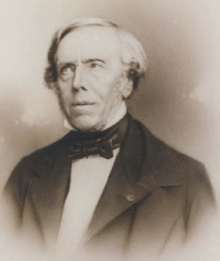Jean-Baptiste-Charles-Joseph Bélanger

Jean-Baptiste Charles Joseph Bélanger (4 April 1790 – 8 May 1874) was a French applied mathematician who worked in the areas of hydraulics and hydrodynamics. He was a professor at the École Centrale des Arts et Manufactures, École Polytechnique and École des Ponts et Chaussées in France. In hydraulic engineering, he is often credited improperly for the application of the momentum principle to a hydraulic jump in a rectangular open channel in 1828. His true contribution in 1828 was the development of the backwater equation for gradually varied flows in open channels (Bélanger 1828) and the application of the momentum principle to the hydraulic jump flow in 1838 (Bélanger 1841).
Life of Bélanger
Born in Valenciennes on 4 April 1790, Bélanger was the son of Charles Antoine Aimé Joseph Bélanger, master locksmith, and of Jeanne Françoise Joseph . He studied in Paris at the École Polytechnique and later at the École des Ponts et Chaussées.
As Ingénieur du Corps des Ponts et Chaussées, he started his engineering career in 1816 at La Réole. From 1821, he moved to work on the Somme navigation canal and after 1826 on the Ardennes navigation canal. It was during these two missions that he studied specifically the hydraulics of gradually varied open channel flows. He later became a lecturer at the École Centrale des Arts et Manufactures between 1838 and 1864, at the École des Ponts et Chaussées from 1841 to 1855, and at the École Polytechnique from 1851 to 1860 (Chatzis 1995). At the École Centrale, one of his students was Gustave Eiffel (1832–1923) who built the Eiffel tower and engraved Bélanger's name around the first floor together with the names of 71 other scientists. Jean-Baptiste Bélanger retired in 1864 and died on 8 May 1874 at Neuilly-sur-Seine where his body was buried.
Contribution to open channel hydraulics
During his professional career, his 1828 treatise was a major contribution to modern open channel hydraulics (Chanson 2008,2009). The work was focused on the study of gradually varied open channel flows (Bélanger 1828). The originality of Bélanger's (1828) essay was the successful development of the backwater equation for steady, one-dimensional gradually varied flows in an open channel, together with the introduction of the step method, distance calculated from depth, and the concept of critical flow conditions. In 1828, Jean-Baptiste Bélanger understood the rapidly varied nature of the jump flow, but he applied incorrectly the Bernoulli principle to the hydraulic jump. The correct application of momentum considerations to the hydraulic jump flow was derived 10 years later and first published by Bélanger (1841) as part of a series of lecture notes for the École nationale des ponts et chaussées. His notes formed a comprehensive treatise in hydraulic engineering (Chanson 2008). They were re-edited several times and used at the École des Ponts et Chaussées and École Centrale des Arts et Manufactures, and available at the École Polytechnique et École des Mines de Paris Altogether Jean-Baptiste Bélanger's (1828,1841) contributions to modern open channel hydraulics were remarkable and influenced the works by Jacques Antoine Charles Bresse, Henry Darcy, Henry Émile Bazin, Adhémar Jean Claude Barré de Saint-Venant, and Joseph Valentin Boussinesq, as well as Philipp Forchheimer and Boris Bakhmeteff.
Contribution to applied mechanics
From 1851, as a Full Professor at the École Polytechnique, he developed a new university curriculum in mechanics (cours de Mécanique) in response to a re-structure of the engineering programme at École Polytechnique (Chatzis 1995). Linking kinematics and dynamics, he argued that the mechanics is based upon three principles: inertia, action-reaction and constant ratio force to acceleration at any point. Among the innovations, he considered statics as a limited case of dynamics which was most innovative in France at the time. His basic ideas were first developed in his 1847 lecture notes, and they influenced many leading scholars in France and overseas. For example, Franz Reuleaux (1829–1905) respected highly Bélanger's (1847) text ; Ernst Mach (1838–1916) listed Bélanger's 1847 treatise among a few basic references in Mechanics.
References
- BELANGER, J.B. (1828)" "Essai sur la Solution Numérique de quelques Problèmes Relatifs au Mouvement Permanent des Eaux Courantes." ('Essay on the Numerical Solution of Some Problems relative to Steady Flow of Water.') Carilian-Goeury, Paris, France (in French).
- BÉLANGER, J.B. (1841). "Notes sur l'Hydraulique." ('Notes on Hydraulic Engineering.') École Royale des Ponts et Chaussées, Paris, France, session 1841-1842, 223 pages (in French).
- BÉLANGER, J.B. (1847). "Cours de Mécanique ou Résumé de Leçons sur la Dynamique, la Statique et leurs Applications à l'Art de l'Ingénieur." Carilian Goeury et V. Dalmont, Paris, France.
- CHANSON, H. (2008). "Jean-Baptiste Charles Joseph BÉLANGER (1790-1874), the Backwater Equation and the Bélanger Equation." Hydraulic Model Report No. CH69/08, Div. of Civil Engineering, The University of Queensland, Brisbane, Australia, 40 pages (ISBN 9781864999211).
- CHANSON, H. (2009). "Development of the Bélanger Equation and Backwater Equation by Jean-Baptiste Bélanger (1828)." Journal of Hydraulic Engineering, ASCE, Vol. 135, No. 3, pp. 159–163 doi:10.1061/(ASCE)0733-9429(2009)135:3(159).
- CHATZIS, K. (1995). "Un Aperçu de la Discussion sur les Principes de la Mécanique Rationnelle en France à la Fin du Siècle Dernier." Revue d'Histoire des Mathématiques, Vol. 1, pp. 235–270.http://smf4.emath.fr/en/Publications/RevueHistoireMath/1/pdf/smf_rhm_1_235-270.pdf
- DARRIGOL, O.(2005). "Worlds of Flow - A History of Hydrodynamics from the Bernoullis to Prandtl.", Oxford University Press, ISBN 0-19-856843-6 [The Bélanger backwater equation is equation (6.6) on Page 224]
